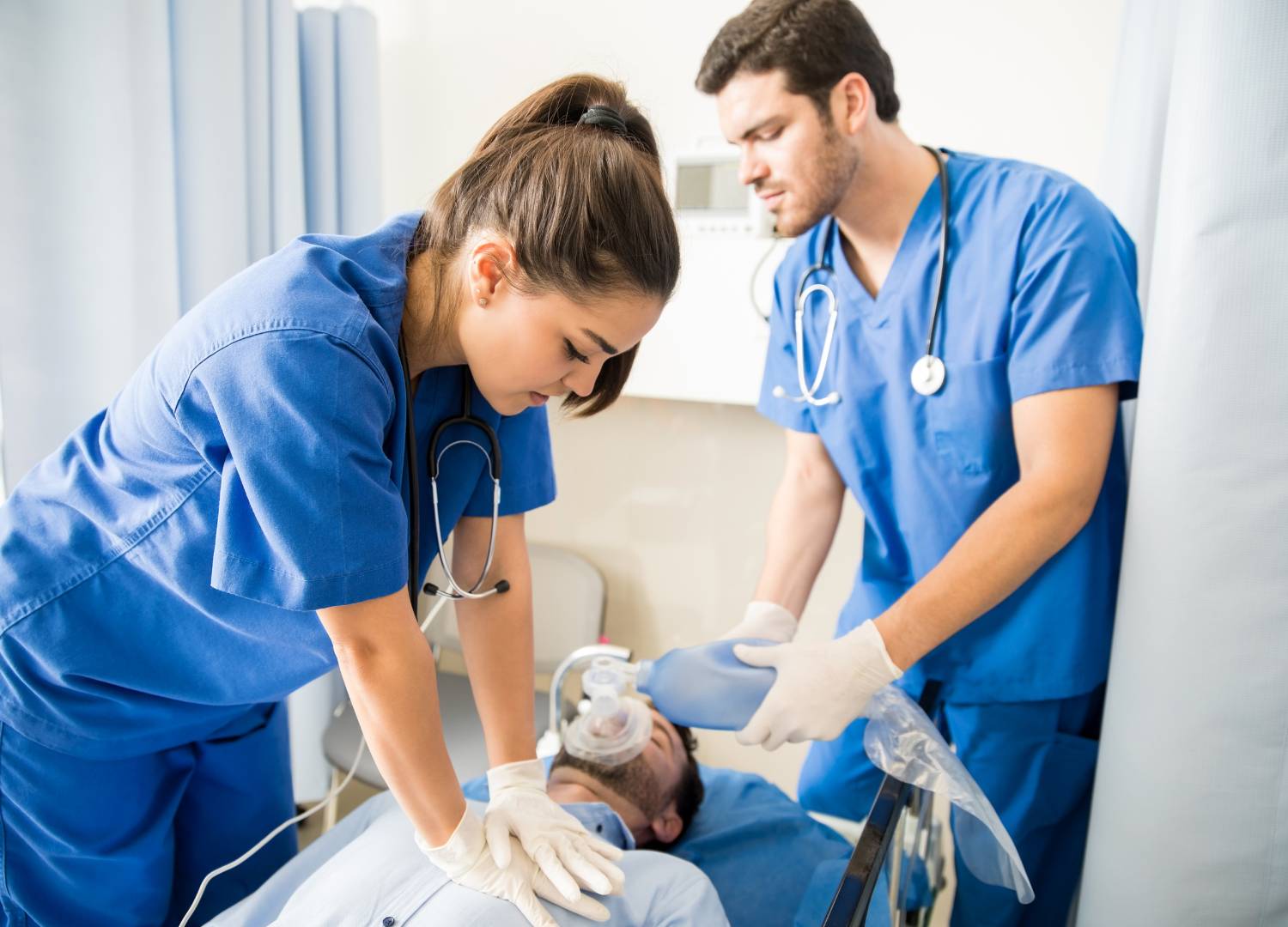Respiratory Arrest: Essential Steps to Take When It Occurs
Respiratory Arrest: Essential Steps to Take When It Occurs

by Greta Kviklyte
Life Saver, AMC
Co-authored by Kim Murray, RN, M.S.
posted on Aug 28, 2024, at 3:15 pm
It is possible for a patient to exhibit with a strong heartbeat but without any signs of breathing. When this occurs, the individual could be suffering from respiratory arrest, a condition that is life-threatening and requires immediate medical attention. It is similar to cardiac arrest, but managed in a slight different manner to restore function to the patient.
Respiratory Arrest Definition: What Is Respiratory Arrest?
Respiratory arrest occurs when a person stops breathing with or without any signs of cardiac function. One condition will lead to the other, warranting immediate medical care as noted by the National Library of Medicine.
We offer Online CPR and BLS Certification
Data from the Merck Manual indicates that any interruption of pulmonary gas exchange for over five minutes has a high chance of creating irreversible damage to a patient including to vital organs like the brain. If respiratory arrest does not improve quickly, cardiac arrest almost always occurs next.
It is possible to provide ventilation to restore breathing. However, if done too aggressively, this can create a negative hemodynamic consequence especially during the peri arrest period if cardiac output is low.
The objective in treating respiratory arrest is to restore adequate ventilation of the patient and ensure oxygenation without compromising the cardiovascular system in any additional manner.
How Does Respiratory Arrest Occur? 
Respiratory arrest may occur for various reasons. The most common instances are caused by:
- Obstruction of the airway
- Decreased respiratory effort
- Respiratory muscle weakness
To further define these, consider the following common but not exclusive indications of respiratory arrest causes, as noted by the National Institutes of Health.
Airway Obstruction Indications
An upper airway obstruction occurs when there is something blocking the airway above the vocal cords. This includes nasopharyngeal and oral cavities, as well as the larynx. Some common causes include:
- Vomit
- Blood
- Mucus
- Edema of the vocal cords
- Spasming of the vocal cords
- Tumor
- Trauma
- Posterior position of the tongue
- Pharngolaryngeal inflammation
- Foreign body
In children who are under the age of three months, who are nose breathers, a blockage of the nasal pathway can also lead to respiratory arrest. This could indicate the need to pursue infant CPR.
Respiratory arrest can also occur as lower airway obstruction, occurring below the vocal cords. This includes the area of the trachea, bronchi, bronchioles, and alveoli. Some of the most common causes include:
- Aspiration
- Airspace-filling disorders, including pulmonary hemorrhage, pneumonia, and pulmonary edema
- Drowning
- Bronchospasm
Decreased Respiratory Effort Indications
A secondary common reason for respiratory arrest is a decreased effort in breathing. This may be brought on by concerns with the central nervous system, such as impairment. This may be due to a central nervous system disorder, metabolic disorder, adverse effects of medication or drug use, or mechanical defects.
CNS disorders typically include the onset of a stroke or tumor but may also be indicative of an infection. It may also be brought on by damage to the cervical spine, causing hypoventilation. Any instances in which there is an increase in intracranial pressure can also cause this to occur.
Numerous medications can slow the breathing rate and ability of a patient. This includes:
- Sedative hypnotic drugs, including alcohol, benzodiazepines, and barbiturates
- Opioids
- Gapapentinoids, including pregabalin and gabapentin
These drugs reduce respiratory effort in the patient and can increase dead space ventilation, resulting in prolonged liberation from mechanical ventilation for those who have a diminished tidal volume in a critical care setting.
Some metabolic disorders can also cause respiratory arrest, including those who have restrictive ventilatory defects or obesity. Medical defects, including respiratory muscle dysfunction, can contribute to a reduction in breathing ability.
Respiratory Muscle Weakness Indications
Numerous factors can lead to the onset of weakened respiratory muscles, leading to the onset of an inability to breathe. This may be caused by respiratory muscle fatigue, neuromuscular diseases, as well as corticosteroid medications.
Respiratory muscle fatigue occurs in situations in which a person breathes for an extended period of time at a minute ventilation that exceeds about 70% of their maximum voluntary ventilation. This leads to metabolic acidosis or hypoxemia. This may be brought on from conditions such as COPD or dysfunction of the muscles.
Neuromuscular dysfunction can occur if there is damage to the spinal cord or the onset of conditions like botulism, myasthenia ravis, or Guillan-Barre syndrome occur. Also notable when a patient is on bedrest and is being given corticosteroids or neuromuscular blocking medications, this can lead to muscle weakness.
Respiratory Arrest vs Failure
Respiratory failure is a life-threatening condition that leads to an impairment of oxygenation, carbon dioxide elimination or both, as defined by the Merck Manual. Respiratory failure occurs when the repository does not oxygenate and eliminate carbon dioxide from the blood. It may be due to either inadequate oxygenation or a lack of elimination of carbon dioxide, both of which are critical components. There are many instances in which both occur.
The most common manifestations of respiratory failure include:
- Dyspnea
- Use of accessory muscles of respiration
- Diaphoresis
- Altered consciousness
- Tachypnea
- Tachycardia
In nearly all situations, it will lead to respiratory death. As a critical condition, it is essential that rescuers know exactly how to support a patient experiencing these types of failure.
Symptoms of Respiratory Arrest
It may not be immediately obvious that a person is not breathing, which is why rescuers must be observant of at-risk individuals for movement in the chest indicating breathing or a lack of it. Some of the most common symptoms may include:
- Extreme shortness of breath, a feeling of not being able to pull in enough air, called dyspnea
- Rapid breathing, called tachypnea
- Fast heart rate, feeling heart palpitations
- Extreme tiredness
- Restlessness
- Pale skin
- Excessive sweating
- Blurry vision
- Bluish tint to the lips, skin, or nails
- Agitation and confusion
- Behavioral changes, such as not acting normal
- Headaches
How to Manage Respiratory Arrest
As with any type of basic life saving process, rescuers must know how to react to the situation occurring. This typically means completing BLS appropriate for the situation including ACLS sequences as necessary.
Complete the following guidelines according to your BLS survey expectations:
- Check for patient responsiveness
- Activate EMS support
- Check for circulation
- Defibrillate
In respiratory arrest, the patient will still maintain circulation. This means that there is typically no need to defibrillate the patient. There is also no need to complete chest compressions or provide formal CPR methods for the patient. Instead, the treatment involves creating successful ventilation, or opening up the airway to allow for breathing.
To follow the ACLS survey, complete the following steps:
- Airway
- Breathing
- Circulation
- Differential diagnosis
In these situations, respiratory arrest typically requires establishing an open airway, a way for the patient to pull air into their body and expel carbon dioxide. Use the tools available to you within the given situation and act in an appropriate manner.
Here is an example. If a patient is experiencing respiratory arrest in a park, the first step will be to open the airway. The head title/chin lift method or the jaw thrust maneuver is the ideal situation. Use the jaw thrust method in situations where there could be damage to the cervical spine.
In situations where there is an oropharyngeal or nasopharyngeal airway device available, such as in a medical center setting, use that to establish an open airway for the patient.
Understanding the Administering of Artificial Respiration
In situations where the patient receives artificial respiration, the rescuer must be cognizant of the fact that they are breathing for the patient. As a result of this, it is critical that they do not excessively ventilation the patient. Rather, notice the chest rising and falling with each breath.
In situations where it is possible to do so, rescuers can supply supplemental oxygen to the patient. This includes using as high as 100% oxygen initially. However, this should be tritating downward. The ultimate goal is to achieve a blood oxygen level of at least 94% or higher. This is based on measurement through pulse oximetry.
Navigating Respiratory Arrest and Cardiac Arrest
It is critical for rescuers to realize that, at any moment, a person with respiratory arrest could enter into cardiac arrest as well. This can happen quickly or over a period of a few minutes. As a result, rescuers need to check the patient’s pulse on a consistent basis to determine if circulation is continuous.
In situations where the patient’s heart stops, follow the necessary treatment and treatment for cardiac resuscitation.
Treatment of Respiratory Arrest Methods 
Depending on the environment and the level of care available, the specific treatments for respiratory failure typically include:
- Application of mechanical ventilation: This is the process of using a breathing machine and a tube placed into the airway to open up the airway and move air in and out of the lungs.
- Extracorporeal membrane oxygenation (ECMO): Used in a medical treatment center, such as an emergency room, placing a patient on ECMO is necessary to support oxigentation needs. This machine works to oxygenate the blood and remove carbon dioxide.
- Oxygen therapy: In some situations, a patient may be given extra oxygen supplied through a breathing mask or cannula. This can be done in an emergency situation and it may remain over time.
- Fluids: Patients are also given fluids through an IV. The fluid helps to increase blood flow through the body, and may help to bring oxygen-rich blood to the tissues, minimizing damage to organs.
In addition to these strategies for the treatment of respiratory arrest, treatment will need to focus on the underlying cause. For some patients, this may require surgical interventions to remove blockages in the airway. For others, it may be necessary to consider cardiac function, edema, and lung conditions. In an emergent situation, a rescuer does not need to apply these longer-term treatments but should be cognizant of the risks the patient faces, such as spinal cord injury if moved.
The ultimate goal of treatment is to restore the function of the body to breathe. To do this, rescuers and emergency care workers must work through the following steps until respiratory arrest improves or additional treatment options are obtained:
- Establish an airway and control it to maintain it
- Utilize an airway or respiratory device to maintain the function of breathing
- Tracheal intubation
- Surgical airway creation
- Medications to aid in intubation
Patients require care right away. Any exposure to a lack of breathing for more than a few minutes begins to lead to brain damage, making resuscitation difficult for the patient.
High Risk Patients for Respiratory Arrest
A person eating can be a victim of respiratory arrest. However, there are some scenarios in which a person is at a much higher risk of developing respiratory arrest than others. The following are risk factors for this condition:
- Individuals with lung conditions, including acute respiratory distress syndrome, chronic obstructive pulmonary disease (COPD), pulmonary fibrosis, cystic fibrosis, asthma, Pneumonia, Pulmonary edema, and pulmonary embolism
- Patients exhibiting signs of chest, spinal cord, or brain injuries such as strokes
- Heart and circulatory conditions and diseases, including previous heart attack sufferers, those with congenital heart disease, shock, and heart failure
- Patients with muscular dystrophy, ALS, severe scoliosis, or Guillain-Barre Syndrome
- Patients with a history of exposure to lung irritants, including from smoking or exposure to air pollution, dust, or chemical fumes
- Drug use and excessive alcohol consumption
- Surgical conditions that require sedation
How to Gain Education, Training, and Certification for Respiratory Arrest
Those who wish to be trained to be ready to act in the event of respiratory arrest can pursue one or more certification options. This includes earning CPR, AED, and First Aid Certifications to help the patient to restore breathing and heart function. This specific treatment will provide insight into infant CPR and chocking, child CPR and choking, as well as application of AED and CPR treatments in an emergency situation.
Additionally, BLS Certification can also provide training and education to those who wish to provide this life-saving treatment to patients in need. For those who are becoming a nurse, doctor, or other provider of medical care, obtaining your BLS certification could be critical to meeting the needs of patients in life-threatening situations.
Complete a BLS Online Certification
Advanced Medical Certification provides an opportunity for anyone to learn how to provide basic life-saving support to a person experiencing respiratory arrest. Learn more about the available BLS online certification course that can provide you with the necessary education and training to know how to react when this type of emergency event occurs.
Explore the other options offered by Advanced Medical Certification to improve your ability to help support people facing emergency needs. Learn more about the services and certifications available at Advanced Medical Certification now.



